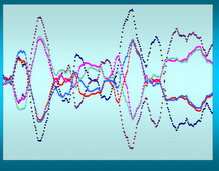The MACD is one of the most frequently used and least understood technical analysis methods known to man (with the possible exception of the RSI but we’ll save that one for later). Again, if you came here looking for confirmation of your methods of doing things you might as well go away. If I can’t bring something new to the discussion I’m bringing nothing at all. Today I’m going to bring it! (Saw that in a movie once and thought it was neat – the statement - not the movie).
The stock I was using as an clinic stock was HANS. And I really don’t know why I put the MACD under it but I did and lo and behold I discovered something. Now when you couple the MACD with Bollinger Bands you get a pretty good filter – especially if you get a volume supported blow-off bottom associated with the stock. You can see that in this figure. Take a moment and look at it carefully then try to figure out what I’m going to do with the MACD.

All of you who said you noticed that HANS went up when the MACD crossed the EMA go to the back of the class and face the wall. The rest of you pay attention. What I noticed was that the MACD histogram (those little lines sticking out of the 0.0 baseline) was in negative territory when the run began. Sometimes we think we should take trades when the MACD histogram crosses 0 and begins to ascend. We think that because that is the easiest way to understand the MACD. I'm going to contend that I have always known that that was probably too late which is one of the reasons why I never used the method. I think I can prove this contention.
I wrote a filter that was as simple as can be. It consisted of three lines as follows:
Show stocks where close is between 15 and 35
And average volume(90) > 500000
And MACD Histogram(12,26) < -.1
That's it - MACD Histogram less than minus .1. You do not get any simpler than that. Then I back tested it. I used my standard entrance criteria – one trade a day using the top volume stock output by the filter with no more than four stocks in play at any one time. I also used my standard exit criteria - hold the stock for four days then automatically sell at the close unless it hits a 10% stop loss in the meantime. If it does hit the stop then sell it at the close and take another trade. Then I ran the test and these were the standardized results:
Number of trades: 73
Win Percentage: 53%
Stop Loss trades: 0
Equity Result: 33602; ROI: 101% and S&P500 ROI during the period: 29.76%
OK – that’s pretty impressive for a simple filter. So then I changed the third line to
And MACD Histogram(12,26) > .1
And reran the test. These were the standardized results:
Number of trades: 73
Win Percentage: 56%
Stop Loss trades:1
Equity Result: 19427; ROI: 60.77% and S&P500 ROI during the period: 29.76%
Whoops – what happened? Apparently you are better off taking the trade when the MACD is below the line than when it is above. That makes sense. Somewhere in the past posts there are a number of articles about taking trades below the EMA 90 or MA 200 rather than above it.
For good measure I changed the test period. I bumped it up a month to have it end last Friday. I ran the second filter first (i.e. the one with the histogram above the line (>.1)). Here are the standardized results:
Number of trades: 64
Win Percentage: 53%
Stop Loss trades: 1
Equity Result: 6115; ROI: 28.89% and S&P500 ROI during the period: 29.54%
Well it was a tough period. The I ran the test for that period with the other, better filter (histogram < -.1) and here are those results:
Number of trades: 64
Win Percentage: 56.25%
Stop Loss trades: 0
Equity Result: 27661; ROI: 100.00% and S&P500 ROI during the period: 29.54%
You be the judge. Maybe the next time you use the MACD to inform yourself of a trade you might want to remember this little exercise. Of course you will want to couple it with another method just to make sure - this little tidbit is only the icing on the cake.
None of my writing is an invitation to gamble, uh, invest in the stock market. If you feel that you must invest in something I suggest you see a psychiatrist immediately. You can do worse with your money.

No comments:
Post a Comment